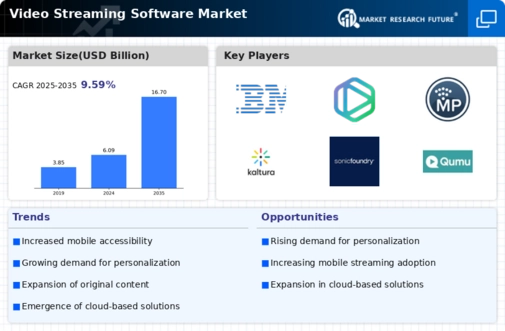Top Industry Leaders in the Video Streaming Software Market

Competitive Landscape of Video Streaming Software Market
The video streaming software market is experiencing explosive growth, fueled by the insatiable demand for online video content across diverse industries. This dynamic landscape is home to a range of established players and emerging challengers, all vying for a slice of the pie. Understanding the competitive dynamics, key strategies, and investment trends is crucial for navigating this lucrative market.
Key Players and Their Strategies:
- IBM (US)
- Agile content (US)
- Brightcove (US)
- MediaPlatform (US)
- Kaltura (US)
- Sonic Foundry (US)
- Qumu (US)
- Panopto (US)
- Vimeo (US)
- Sproutvideo (US)
- Wowza (US)
- Haivision (Canada)
- Brick (US).
Factors for Market Share Analysis:
- Feature Set and Functionality: The breadth and depth of features offered by a platform, ranging from content management and analytics to security and monetization tools, play a crucial role in attracting and retaining customers.
- Deployment Options: Flexibility in deployment, including cloud-based, on-premise, and hybrid models, cater to diverse customer needs and preferences.
- Pricing and Scalability: Affordable pricing models and the ability to scale seamlessly with growing content volumes are critical for market competitiveness.
- Target Audience and Vertical Focus: Companies that cater to specific industry needs, like education, healthcare, or corporate training, have an edge over generalized platforms.
- Technology Innovation: Investment in cutting-edge technologies like AI-powered content delivery, VR/AR integration, and interactive features can set players apart.
Emerging Companies and Trends:
- Livestreaming Startups: New platforms like Twitch and Discord are attracting large audiences with interactive live streaming experiences, particularly in the gaming and entertainment sectors.
- AI-Powered Personalization: Companies like Vidora and Qwilt are harnessing AI to personalize video recommendations, improve content discovery, and optimize delivery for individual users.
- Social Video Platforms: The rise of TikTok and Instagram Live demonstrates the immense potential of social video, blurring the lines between traditional streaming platforms and user-generated content.
Current Company Investment Trends:
- Acquisition Spree: Established players are on the lookout for acquiring niche technologies and smaller platforms to expand their feature sets and reach new customer segments.
- Global Expansion: With the video streaming market booming across the globe, many companies are investing in international expansion and localization of their platforms.
- Partnerships and Integrations: Strategic partnerships with technology providers, content creators, and distributors are becoming increasingly common to build a robust ecosystem and offer comprehensive solutions.
- Focus on Cloud-Based Solutions: The shift towards cloud-based video platforms is evident, driven by their scalability, flexibility, and ease of deployment.
Product Launches and Innovations:
- Mux launches a new live-streaming API with built-in analytics and content protection features. (January 8, 2024)
- Dacast introduces a new cloud-based video transcoding service with support for multiple video formats and resolutions. (January 19, 2024)
- Vimeo announces the release of its new "Vimeo OTT" platform for businesses to launch their own branded video-streaming services. (January 30, 2024)
Challenges and Concerns:
- The increasing fragmentation of the video-streaming market with multiple players vying for viewer attention is leading to content competition and user churn. (January 9, 2024)
- Data security and piracy remain major concerns for video-streaming software companies, with concerns about user data breaches and unauthorized access to content. (January 23, 2024)
- The emergence of new technologies like virtual reality and augmented reality could disrupt the traditional video-streaming landscape and create new challenges for software companies. (January 28, 2024)









